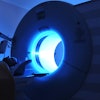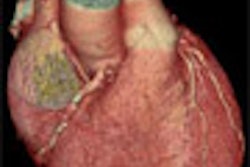A rather gutsy clinical study by Italian radiologists pitted state-of-the-art chromoscopic high-magnification colonoscopy against prepless virtual colonoscopy. The researchers, from the University of Rome "La Sapienza," found that advanced colonoscopy did a better job of identifying flat lesions, particularly the smallest ones.
The seemingly uneven pairing of tests was necessary because standard optical colonoscopy does a poor job of detecting flat lesions in its own right, and only an advanced endoscopic exam could serve as an adequate reference standard, the researchers hypothesized.
"A polyp is considered flat when it has a base that is at least twice as long as its height," explained Dr. Riccardo Iannaccone at the 2005 RSNA meeting in Chicago. "And in practice, flat polyps tend to have a height of 2 mm or less."
Originally thought to be a phenomenon largely associated with Japanese populations, the flat polyp's prevalence and clinical significance in Western countries remain controversial. Still, a handful of studies have reported prevalances of 6% to 36% for flat or depressed lesions even in Western countries, including studies by Remacken et al (Lancet, April 8, 2000, Vol. 355:9211, pp. 1211-1214) and Saitoh et al (Gastroenterology, June 2001, Vol. 120:7, pp. 1657-1665).
"There is also evidence that such lesions might show aggressive behavior, although this issue is controversial," Iannaccone said. "Certainly flat adenomas are difficult to detect ... at optical colonoscopy performed with a standard technique, and they are hard to spot with CT colonography (VC), although we also have one study by Dr. Pickhardt (et al) that showed promising results for flat lesions."
Dr. Nobuyuki Shiraga, chief of radiology at Tachikawa Kyosai Hospital in Tokyo, also led a successful VC study of flat lesions that was presented at the 2002 RSNA meeting.
For their study, Iannaccone and colleagues examined 62 consecutive patients with clinical indications for colonoscopy. Two days before CT imaging, all patients underwent a fecal tagging preparation consisting of 1 mL of diatrizoate meglumine and diatrizoate sodium (Gastrografin, Bracco, Milan, Italy) for each kilogram of patient body weight. The average dose was 70 mL (62-108 mL).
No cathartic preparation was used prior to CT, although the Gastrografin preparation is known to produce a mild cathartic effect. CT was performed in the supine and prone positions following manual colonic insufflation with room air.
Imaging was performed on a 64-slice scanner (Sensation 64, Siemens Medical Solutions, Erlangen, Germany) at 64 x 0.6-mm collimation, 0.6-mm section thickness, pitch of 1.4, 100 effective mAs, and 120 kVp.
Segmentally unblinded colonoscopy following complete cathartic cleansing was performed three to seven days after CT, and was used as the reference standard. The endoscopies were performed using a high-magnification colonoscope for chromoscopy and dye spraying to facilitate detection of flat colorectal polyps.
"The catheter is inserted into the colon, a methylene blue dye (enema) stains the colonic mucosa, and magnified images increase the conspicuity for detection of the stained polyps," Iannaccone said. "The magnification can be turned up to 160x, and the staining is performed ... to accentuate the lesion contours."
Three independent radiologists who were unaware of the colonoscopic findings analyzed the VC images using a software package for primary three-dimensional reading that allows for electronic subtraction of tagged stool (V3D Colon, Viatronix, Stony Brook, NY). Sensitivity was calculated on a per-lesion basis, interobserver agreement was calculated using the k-statistic, and procedure time was also recorded.
According to the results, 38 flat colorectal polyps were identified at high-magnification chromoscopic colonoscopy. Of these, 17 (44.7%) were hyperplastic and 21 (55.3%) adenomatous or more advanced. Virtual colonoscopy identified 14 of 38 flat polyps for an average sensitivity of 36.8% (75% for flat polyps with widths of 8 mm or larger). Interobserver agreement was moderate to high.
Why was VC's overall performance so poor? "Most flat lesions had a width smaller than 8 mm and height inferior to 2 mm," Iannaccone said, and therefore were difficult to visualize on the colonic mucosa. "Indeed, none of the 24 flat polyps that we missed prospectively could have been identified retrospectively."
Chromoscopic colonoscopy was time-consuming, requiring on average 42 minutes, compared to 17 minutes for the VC exam, and nearly as long for interpretation.
The small cohort size limited the value of the results, Iannaccone said. "In addition, we have to acknowledge that CT colonography with standard cathartic cleansing in theory could show better results because a large amount of residual stool in the colon might have (hidden) some of the flat lesions against the mucosa. Also we did not evaluate the role of IV contrast and computer-aided detection."
For its part, the use of chromoscopic colonoscopy is limited by higher costs, the need for special training, and its lengthy exam time, he said.
"The identification of flat polyps at 64-slice CT colonography without cathartic preparation is problematic, especially in polyps with widths less than 8 mm and height less than 2 mm," Iannaccone concluded. In response to an audience question, he said the study was too small to make any conclusions about the prevalence of advanced dysplasia among flat lesions compared to other polyp types.
Dr. Abraham Dachman, professor of radiology at the University of Chicago, spoke of the ongoing debate over the significance of flat lesions.
"This is going to be a raging topic in VC for several years because it's a raging topic in the gastroenterology community," Dachman said. "In other words, the gastroenterology academics are trying to push the nonacademics to use special (colonoscopic) techniques."
The National Polyp Study found no increased prevalence of dysplasia among flat lesions compared to other lesions of comparable size, he added.
By Eric Barnes
AuntMinnie.com staff writer
January 17, 2006
Related Reading
Virtual colonoscopy picks up flat lesions, November 15, 2004
Virtual colonoscopy aces first flat-lesion study, December 3, 2002
Copyright © 2006 AuntMinnie.com



















